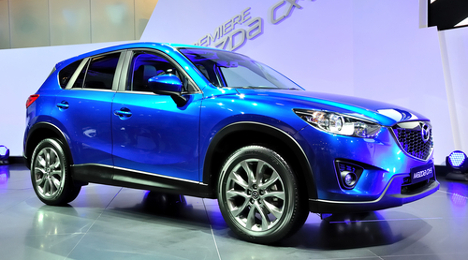The U.S. Department of Transportation’s National Highway Traffic Safety Administration hosted a media conference call on Friday, outlining its current actions and future plans to prepare for the impending legislative needs of the United States in regards to future automated automobile technologies.
NHTSA’s communications director Gordon Trowbridge fielded many questions from journalists and industry analysts, including quite a few trying to get a better idea of when we can expect automated technologies, such as self-driving vehicles, to actually become a widespread reality. In short, Trowbridge made it clear that NHTSA’s role in the situation is to make sure it is prepared when such technologies do become widespread, not to decide when it actually happens.
The fact that the automotive and technology industries appear to be getting closer to making self-driving cars a reality in the next decade is evident, however, and NHTSA says it is taking several further actions to prepare.
One such action is to hold two separate public meetings in April to allow interested parties to come and provide feedback to NHTSA with their concerns and suggestions to help the federal body develop guidelines for the safe development of automated safety technologies.
The first will be held on April 8 in Washington, D.C.; the second will be held later in April at a yet-to-be-disclosed location in California, according to Trowbridge. He says that additional information for the California meeting, including the time, location and how the public can participate, will be released soon.
Trowbridge also said that NHTSA has engaged in a number of conversations with state legislations to get a dialogue rolling to keep the lines of communications open between state and federal governments on the topic of automated vehicle technologies. In terms of who will decide whether a vehicle’s automated technologies are safe, whether it be state or federal authorities, is still undefined.
In a release from NHTSA, Transportation Secretary Anthony Foxx commented on the organization’s goals in this situation.
“We are witnessing a revolution in auto technology that has the potential to save thousands of lives,” Foxx said. “In order to achieve that potential, we need to establish guidelines for manufacturers that clearly outline how we expect automated vehicles to function — not only safely, but more safely — on our roads.”
Establishing operational guidelines is just one of five of NHTSA’s initiatives that Foxx announced in January during the North American International Auto Show in Detroit. Here are the other four, as NHTSA listed in the release:
- President Obama’s budget proposal for a 10-year, $3.9 billion investment in advancing autonomous vehicle technology, including large deployment pilots in communities around the country.
- Working with states to develop model state policy.
- Using NHTSA’s existing authority to interpret current regulations, and offer limited exemptions from those regulations, in pursuit of advances that could increase safety.
- Determining what new regulatory tools and authorities might be required to meet NHTSA’s safety mission in an era of rapidly changing technology.
NHTSA also released its initial assessment of current Federal Motor Vehicle Safety Standards to identify the key challenges ahead between now and the full deployment of automated vehicles.
The report, prepared by the USDOT’s Volpe National Transportation Systems Center, basically found that there are very few existing federal regulatory hurdles for the deployment of automated vehicles that feature traditional designs and equipment that accommodate a human driver, for example those containing traditional controls like a steering wheel, gas and brake pedals, etc. According to Trowbridge, the biggest challenge will be in the area for new automated vehicles designs that don’t feature such traditional designs.
NHTSA Administrator Mark Rosekind commented on the findings of the report in a release from the administration earlier today.
“The Volpe Center report is a great first look at current standards, and it highlights the need for the actions Secretary Foxx outlined in January,” Rosekind said. “It also shows there are few current restrictions on some automated vehicle concepts, which highlights the need to establish clear expectations for their safe operation. At the same time, for other vehicle designs, the agency has more work to do to ensure the safety of new innovations, and we look forward to learning more from stakeholders as we start that work.”
The full report from The Volpe Center can be accessed here.
In a previous article I provided tips on how dealerships can prepare to receive vehicle shipments, and emphasized the importance of doing a thorough inspection at both the origin pickup location and destination (receiving) location. In that article, I pointed out the distinction between normal wear and tear versus major damage.
It’s difficult to define what “normal wear and tear” is because it’s very subjective. So much so that two people looking at the same car can have very different opinions about what is or isn’t normal wear and tear.
For example, on a recent visit to a pre-owned car dealership, a buyer noted a broken taillight as damage, while a service writer noted it as normal wear and tear because of the age of the vehicle.
Experience also plays a role in the subjectivity of vehicle inspections. At another dealership, a porter inspecting a vehicle claimed a ding on the car was transportation damage. Upon getting a second opinion from an experienced service writer, they decided it was not transportation damage.
For new cars, there are defined standards, damage codes and inspection procedures to follow before the vehicle is even removed from a bay location. Each party along the supply chain has defined procedures.
For pre-owned vehicles, however, there are no universal standards at this time. Leasing companies, dealerships and auctions will all have their own guidelines for what constitutes normal wear and tear.
From a dealership perspective, vehicles bought online will almost always have pictures to show the condition of the vehicle. The dealer expects to receive the vehicle just as it was shown in the pictures, and expects not to see damages that were not noted in the vehicle condition report.
From a carrier’s perspective, so much can happen before a vehicle is even issued to a driver. That’s why it’s equally important for drivers to conduct a thorough inspection prior to moving the vehicle, and to take pictures if there are any doubts. Most importantly, they should write down any perceived damage on the Bill of Lading and have the origin point of contact acknowledge it.
Perhaps one day industry associations will get together and develop comprehensive and mutually-agreed-upon standards for what constitutes normal wear and tear on pre-owned vehicles. In the meantime, I am advocating for the education of all involved parties on the importance of vehicle inspections and proper documentation on the Bill of Lading.
Don’t let a subjective inspection and claim of damage cost you money.
Martha Garcia-Perry is Director, Account Management with MetroGistics (www.metrogistics.com).
If you’re a dealer, protecting your customers is about more than protecting your business; it’s about contributing to the overall wellbeing of your community.
So with issues on a large scale as huge as the potential risks caused by Takata’s airbag inflator ruptures, the more you know, the more you can potentially protect yourself, your business and your buyer base.
On that note, some big news broke this week about the Takata airbag inflator issues: a partnership of 10 automakers, called the Independent Testing Coalition, announced that an independent engineering firm has released the results of an investigation into the Takata airbag parts to see what, exactly, is causing them to sometimes rupture and subsequently maim drivers with shrapnel.
According to Orbital ATK, the aforementioned independent engineering firm behind the findings, the following are the three key factors that contribute to the rupture of Takata airbag inflators, as listed by the firm:
- The presence of pressed phase stabilized ammonium nitrate propellant without moisture absorbing desiccant;
- Long term exposure to repeated high temperature cycling in the presence of moisture; and
- An inflator assembly that does not adequately prevent moisture intrusion in high humidity.
In short, the vehicles with airbags whose inflators do not contain desiccants that spend great deals of time in hot and humid areas are the units most prone to rupture.
To be specific, some of Takata’s airbags contain desiccants and some do not. The results of this study apply solely to the inflators that are subject to National Highway Traffic Safety Administration recalls 15E-040 to 15E-043, which use a propellant of non-desiccated phase-stabilized ammonium nitrate, or PSAN. They make up the vast majority, roughly 23 million of the 28 million, of the Takata airbag inflators that have been recalled by NHTSA to date.
Backed by Orbital ATK’s 20,000 hours of testing and analysis by experienced engineers, scientists and technicians, David Kelly, former NHTSA acting administrator and ITC coordinator says this is a critical beginning to remedying the Takata issue.
“Identifying this multivariate root cause is an important first step,” Kelly said in the news release from Orbital ATK. “The ITC will use this data to develop our comprehensive understanding of this critical issue.”
Michelle Krebs, Autotrader’s senior analyst, resonated that sentiment in an Autotrader/Kelley Blue Book analysis.
“Finding definitive causes of what went wrong with Takata airbags is a huge step forward in ultimately resolving the problem and providing a pathway for the future in airbag development,” Krebs said. “Just as important, the process used to investigate flawed Takata airbags, which brought together outside experts as well as engineers from a host of automakers, is a great example of how industry problems can be solved.”
These results are the first phase in a multi-layered investigation into the defective Takata airbag inflators. In the next phase, the investigators will focus on all inflators that are being used as replacement parts for current recalls and analyze how they are expected to perform.
“The biggest challenge to this recall is getting the repairs done, and even then, those repaired vehicles may have to be reengineered if ammonium nitrate is found to be unsuitable,” KBB senior analyst Rebecca Lindland said in the same analysis. “This recall is not going away any time soon, and hopefully the death toll won’t rise while the investigation continues.
“The toll on resources this recall is absorbing within the affected parties cannot be underestimated. NHTSA, automakers, Takata itself and other parties all will be tied up in this for years to come while the expense mounts.”
As voters are driving out to participate in primaries and caucuses, do you ever wonder what they’re driving?
The folks at BestRide, a car-shopping website, and CarTalk, a nationally syndicated radio program, have done the legwork for you — and some of the results from the more than 10,000 respondents they polled may surprise you.
According to BestRide and CarTalk’s recent analysis, Toyota Prius drivers are 40 percent more likely to support Hillary Clinton than the general population.
But, wait, this next Prius-driver fact is a bit polarizing — they are 126 percent more likely to support Ted Cruz than the general population.
As for Dodge, which is arguably best known for its muscle cars and big trucks, its owners are 50 percent more likely to support Donald Trump compared to the general population.
And drivers of the fuel-conscious Honda Fit as well as Subaru Forester drivers, they’re “feeling the Bern,” as they’re more likely to support Bernie Sanders compared to the general population.
Supporters of Clinton and Sanders are both tied at an average fuel economy of 28.5 miles per gallon for their registered vehicles. The average fuel economy for Rubio and Cruz followers both came in at 24.7 mpg while Trump supporters averaged 23.6 mpg from their registered vehicles.
Looking at the owners of electric vehicles, 86 percent of the responses were for a Democrat while 14 percent supported a Republican.
To check out the full results of the BestRide study, click here.
Iowans lean toward domestic makes, New Hampshirites reflect national averages
In other cars-and-campaign musings, Edmunds.com recently took a look at the buying tendencies in the first two states to host their individual primaries and caucuses: Iowa and New Hampshire.
Looking at 2015 new-car registration data, Edmunds found that 63 percent of Iowan purchases last year were from domestic brands — compared to the national average of 42 percent.
In New Hampshire, the purchase of American-made vehicles was much closer last year, coming in at 40 percent. New Hampshirites do love their Japanese-made vehicles, though — 46 percent of the new vehicles sold in New Hampshire in 2015 were Japanese, compared to the national average of 41 percent.
If you’re embracing technology as a dealer, you’re likely already swimming in a sea of acronyms. You’ve got your CRM. Your DMS. You’ve got things covered from SEO all the way to F&I. But perhaps a lesser known acronym, VRM, or vehicle relationship management, seems to have a bit more vague definition depending on whom you ask.
But if you ask Roger Penske, Penske Automotive Group’s chairman and chief executive officer, what VRM means to him, he may tell you how it means trying to hold on to a car throughout the retail process, from the first sale all the way to its third, perhaps.
Penske Automotive hosted its fourth-quarter and full-year financial results conference call on Thursday, and one question fielded by Penske resonated with the topic of VRM: How does Penske Auto see the impending used-vehicle volume increase from the expected wave of off-lease vehicles? Is it a certified pre-owned opportunity? What’s the net effect on the company?
Pointing out that used inventory is actually down by roughly 1,000 units overall from where they were a year ago, Penske said he sees it as an opportunity to not only work on customer loyalty, but also keep the cars coming back again and again to bolster gross profits.
“I’ll give you a quick example,” he said. “In Atlanta, where we have two BMW stores that do over 300 used cars a month, probably 10 percent would be coming out of their loaner car fleet every month, another 10 percent would be non-BMW trades, and the rest are BMW.
“I think the ability for us to be able to recondition those, we get the benefit of that in our shops, in the parts and service, and then the ability to utilize some of the OEM’s programs,” Penske said. “That’s one of the things I don’t think people realize … both Mercedes and certainly BMW — and I know Toyota does — they have some very attractive programs on used cars that come out of loaner service or come off lease. Especially if you CPO them. So we’re going to take advantage of those.”
Penske says the company is aiming for a 50 percent to 60 percent loyalty rate from his off-lease customers – whether that means they re-lease that same car, buy it, or choose to lease or buy another vehicle. Keeping that initial vehicle to be sold again and again — that’s Penske’s idea of VRM.
“We want to keep that vehicle, we want to take the vehicle from the customer off-lease, we want to sell or lease it to a second person and then get it back and then retail it at the end,” Penske said. “There’s some real opportunity for gross profit on each vehicle. We don’t want to lose those vehicles as they come through the cycle.”
There are over 47 million vehicles in the United States that have at least one unrepaired safety recall. That’s according to a recent analysis from Carfax, who pointed out that these 47 million vehicles are being driven, bought and sold, or sitting on a lot somewhere in our country, either because there’s not a fix available or because they're waiting on one or whoever owns the vehicle simply hasn’t taken the time to take it in.
To put that number in perspective, the current U.S. population is just short of 323 million (and has netted roughly 20 new Americans in the time it took to write this article) according to the United States Census Bureau.
Carfax says that 47 million number is more than a 1 million net increase in unrepaired recalled vehicles compared to last year. And every state in the union has at least 100,000 of them within its borders.
"Our data shows there's still much hard work to be done in addressing recalls," Carfax communications director Larry Gamache said in a news release. "Many people still are unnecessarily risking their lives by not staying informed or taking action when their vehicle is under a recall. It's one of the many reasons family-oriented vehicles, including one in four minivans, are the most-highly impacted. Carfax continues to work closely with the auto manufacturers so we can alert people in the U.S. and Canada that their vehicles have a potentially dangerous defect that needs to be fixed."
In a recent interview with Auto Remarketing about a separate recall-related matter, Karl Brauer, Kelley Blue Book’s senior director of automotive industry insights, discussed the changing environment of automotive recalls — which historically have carried a “fairly low priority.”
“Consumers, by the way, are just as much of a problem as the government or the dealers, because they have a horrible record of taking the vehicles in when they’ve gotten their notice,” Brauer said. “I don’t know what it is today, but in the past if you got anything over 50 percent of all vehicles involved in a recall to actually be processed and have it addressed, that was considered relatively good. And anything over 66 to 70 percent was like a home run… I just don’t think the patience now exists for that attitude.”
Citing data from the National Highway Traffic Safety Administration, Carfax points out that more than 51 million recalls were issued in 2015, more than any year prior.
"Millions more vehicles will likely be recalled this year, adding to the ones already with outstanding airbag recalls, ignition switch recalls, electrical system recalls and more,” Gamache said. “Resources like myCarfax that continuously monitor your car and send alerts to your mobile device are helping people everywhere find and fix more recalls.”
The recent Iowa caucuses are in the books and it’s time to shift the political focus to Tuesday’s New Hampshire primaries.
Similar to the tight legislative races vying for each party’s presidential nominations, the Edmunds.com data for New Hampshire shows that many of the state’s new-car buying tendencies are similar to the national averages.
Let’s break it down by the numbers. Forty-two percent of new-car purchases made in 2015 in the United States were bought from domestic brands. In New Hampshire, just under 40 percent of the vehicles bought last year were domestic.
One area New Hampshire differs substantially from the rest, however, is in the purchase of Japanese-made vehicles. Forty-six percent of the new vehicles sold in New Hampshire last year were Japanese, compared to the national average of 41 percent.
Another area where New Hampshire is similar to the national scope is by vehicle type. SUVs made up 41 percent of the state’s purchases last year, compared to 37 percent nationally.
This was followed by 37 percent cars (44 percent nationally), 18 percent trucks (15 percent nationally) and 4 percent vans (the same as the national average).
Following Iowa’s theme of blue-collar status, New Hampshire showed a substantially lower average number of luxury new-car sales last year, with a take rate of 8 percent (compared to the national average of 13 percent).
The state fell almost perfectly in line with the national average of sales share by fuel type, with the majority being gasoline-powered (85 percent in N.H., 83 percent nationally), followed by 11 percent flexible-fueled (11 percent both in N.H. and nationally), diesel (3 percent both in N.H. and nationally), hybrid-powered (2 percent in N.H., 3 percent nationally) and EVs (0.1 percent in N.H. and 0.4 percent nationally).
To check out our similar analysis of vehicles sold in Iowa last year, click here.
Toyota, Lexus and Mazda have all recently released information regarding airbag-related recalls, while Mazda has also issued a separate recall related to an issue with the fuel filler pipes in its recent CX-5 vehicles.
Let’s break them down by recall size.
Toyota/Lexus recall 320,000 Land Cruiser, 4Runner, Tundra, Sequoia, LX and GX vehicles
Toyota announced Tuesday that it is recalling 320,000 various vehicles from both the Toyota and Lexus lineups for potentially faulty curtain-shield airbags (CSAs).
The vehicles include model year 2003-2006 Toyota Land Cruiser, 2004-2006 Toyota 4Runner, 2005-2006 Toyota Tundra and Sequoia, 2003-2006 Lexus LX 470 and 2004-2006 Lexus GX 470 vehicles.
According to Toyota, the involved vehicles’ CSAs, due to improper programming in the airbag control modules, can possibly activate when not necessary, along with their seatbelt pretensioners.
All known owners of the involved vehicles will be notified by first class mail.
Mazda issues stop sale, recall for all 2014-2016 CX-5 vehicles (264,463 vehicles)
Mazda announced Monday that it had filed a safety defect report to NHTSA for possible issues with CX-5 vehicles’ fuel filler pipes, which could rupture during a rear collision and potentially cause fuel leakage.
The recall covers all 2014-2016 CX-5 vehicles, translating to approximately 264,463 vehicles affected by this issue in the U.S.
Mazda says there are no reports of accidents or injuries due to this issue.
The company has instructed its franchise dealers to issue a free loaner, demo or rental vehicle to customers with concerns about driving their vehicle before a repair is available.
Mazda recalls 19,000 2004-2006 B-Series trucks with Takata driver-side airbags
Mazda announced Monday it has decided to recall all 2004-2006 model year B-Series trucks that are equipped with Takata drive-side frontal airbag inflators.
Approximately 19,000 of these vehicles affected are located in the U.S., Puerto Rico and Saipan.
These same vehicles are already subject to a previous recall for their Takata-sourced passenger-side frontal airbag inflators.
Lexus recalls 5,000 2016 RX 350 and RX 450h vehicles
Lexus announced toward the end of January the recall of roughly 5,000 model year 2016 RX 350 and RX 450h vehicles for a potential issue with their driver’s knee airbag module.
The company says these modules may not have been properly manufactured, affecting the performance of the airbag and increasing the risk of injury in a crash. All known owners will be notified by Lexus via first class mail.
The NCM Institute recently completed its eighth General Management Executive Program (GMEP) curriculum and awarded 11 managers and future executives with certificates of completion for its dealer development program.
Orchestrated by NCM Associates, officials explained GMEP's comprehensive curriculum emphasizes financial and operational best practices, along with a solid leadership foundation that will strengthen and prepare the dealerships for long-term sustainability. At the completion of this rigorous program, GMEP students will have honed and developed the leadership skills and data analysis experience to maximize profitability and drive success.
“Our recent GMEP class was composed of exceptional leaders from the automotive industry," said Richard Head, director of education at the NCM Institute.
“These graduates have faced every challenge during their 10-month commitment, from carefully evaluating all aspects of their work to critically analyzing their strengths and weaknesses as leaders,” Head continued.
“Thanks to the investment made by their dealer sponsors, each of them is poised to make a remarkable impact at their individual dealerships. And, because of this intensive curriculum, these leaders have formed a comradery that will last them a lifetime,” Head went on to say.
The following is the list of graduates who received their GMEP certificate of completion plaques in January.
— JR Amato, Amato Auto Group, Milwaukee
— Blaine Balderston, Blue Springs Ford, Blue Springs, Mo.
— Brad Cook, Limbaugh Toyota, Birmingham, Ala.
— Ryan Drouin, Grand Subaru, Bensenville, Ill.
— Matthew Greenblatt, Matt Blatt Kia, Egg Harbor Township, N.J.
— Kyle Harris, Blue Springs Ford, Blue Springs, Mo.
— Shaun Leonard, Murray Kia, Conshohocken, Pa.
— Josh Pettee, Tom Wood Subaru, Indianapolis
— Mark Phillips, McGrath Honda of St. Charles, St. Charles, Ill.
— Adam Secore, Merchants Automotive Group, Hooksett, N.H.
— Greg Tomlin, Park Cities Ford Lincoln, Dallas
“Anyone can say, ‘These are the numbers and do this,' but NCM's instructors take the time to explain the how and the why,” Phillips said.
“To accomplish this, they must care, and it is obvious that they not only know and believe what they present will make us all better business people and people, but that they care about us as individuals,” he continued.
“I know this course and the way NCM assisted in my education will make me a better person and leader of my store,” Phillips added.
The next GMEP class is forming now, with the first session beginning March 7.
For information about the General Management Executive Program or the NCM Institute and its complete suite of classroom, Web-based and private management training, call (866) 756-2620.
Connected-car service provider Airbiquity released its 2016 industry predictions on Wednesday.
Scott Frank, the company’s vice president of marketing, says we can expect the rapid pace of technology development related to connected vehicles to continue.
"Automotive continues to face significant challenges—and opportunities—for connected car technologies and programs. The industry has only begun to scratch the surface of what is yet to come," Frank said. "A decade ago, no one could have predicted the rate of technology evolution or level of competition the industry is experiencing today. One thing we know for sure is the pace isn't going to let up; in fact it's going to accelerate."
Here are a few of Airbiquity’s predictions for 2016, provided by the company:
- Increased recognition of automotive leadership threats by non-traditional technology players: Well-known and highly capitalized Silicon Valley technology companies like Google, Apple, Tesla, Uber and Lyft are declaring their ambitions to be automotive industry disruptors and leaders – and consumers are receptive to the idea based on the dominance of their brands, products, and track records of vision and innovation. To counter this threat, traditional automakers will fast-track internal transformations to adopt new technologies, embrace new ecosystem partners, and change outdated processes and procurement policies that are hindering progress. The good news is automakers are increasingly aware of the stakes and taking action. The bad news is a daunting task lies ahead that will test automaker management teams top-to-bottom, as well as the rank and file that must get on board to make it happen.
- Tighter integration of connected vehicle programs with product and customer life cycles: In addition to providing consumers with in-vehicle infotainment content, connected cars are unique in the ability to receive remote software updates to fix recalls and enhance features, as well as provide data about vehicle operations and driving history. This ability presents tremendous cost savings and consumer engagement opportunities for automakers such as reducing recall expense, enabling real-time part and system evaluation, optimizing back-office operations and supply chain, and introducing new driving centric services and monetization. But seizing these opportunities will require automakers to better integrate the strategy and operations of connected vehicle service functions with long standing areas like design and engineering, customer experience and support, brand and marketing, and dealer channels. In 2015, Airbiquity saw an increased maturity of automaker connected vehicle service organizations, and we expect this trend to continue through 2016 given the significant brand stakes and increasingly attractive return-on-investment.
- Increased focus on developing and deploying electrification and autonomous technologies: Automakers will increase investments for the development of technologies to improve electric vehicle performance and expand autonomous driving features. Regarding electrification, oil prices and consumer demand for electric vehicles may be low today, but increasing global warming concerns and efficiency mandates will press automakers to improve fleet efficiencies. Gas prices will eventually increase followed by consumer demand for more efficient vehicles across all price ranges. In response, automakers must ensure they have the right product at the right time to remain competitive. As far as autonomous goes, the future is clear: It's going to happen. If automakers want a slice of the autonomous pie they have to develop and equip vehicles with enabling technologies. The road to fully autonomous vehicles will be a long one (Airbiquity predicts 2030-35) and there will be bumps along the way. To succeed automakers need to put their stakes in the ground now.
Airbiquity is perhaps best known for Choreo, its cloud-based service delivery platform. The company says it has over 7 million vehicles subscribed to Choreo, which facilitates hundreds of millions of connected car transactions per month in the more than 60 countries and 30 languages that the solution is offered.
For more information about Airbiquity, visit its site here.












